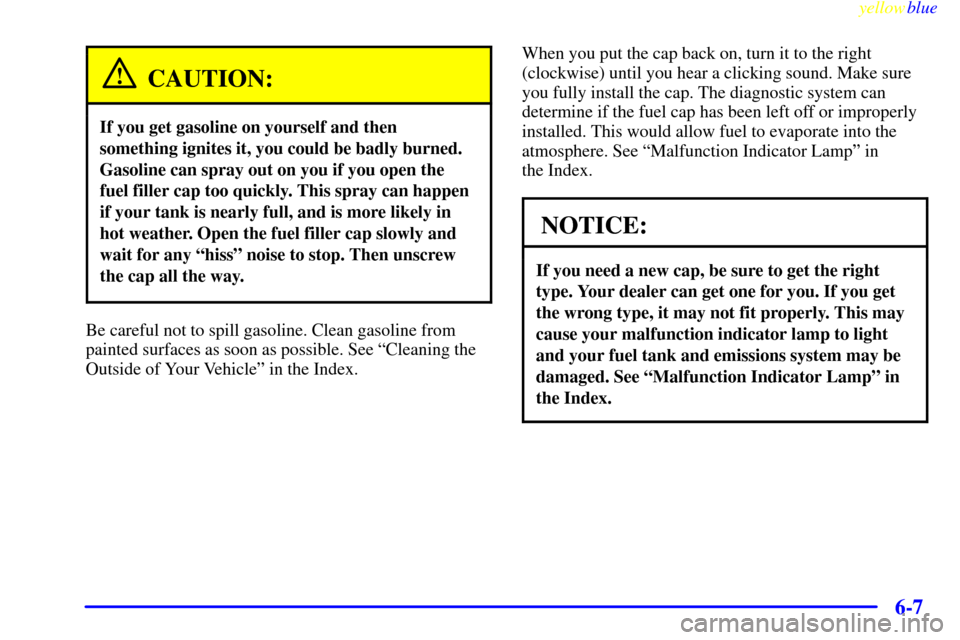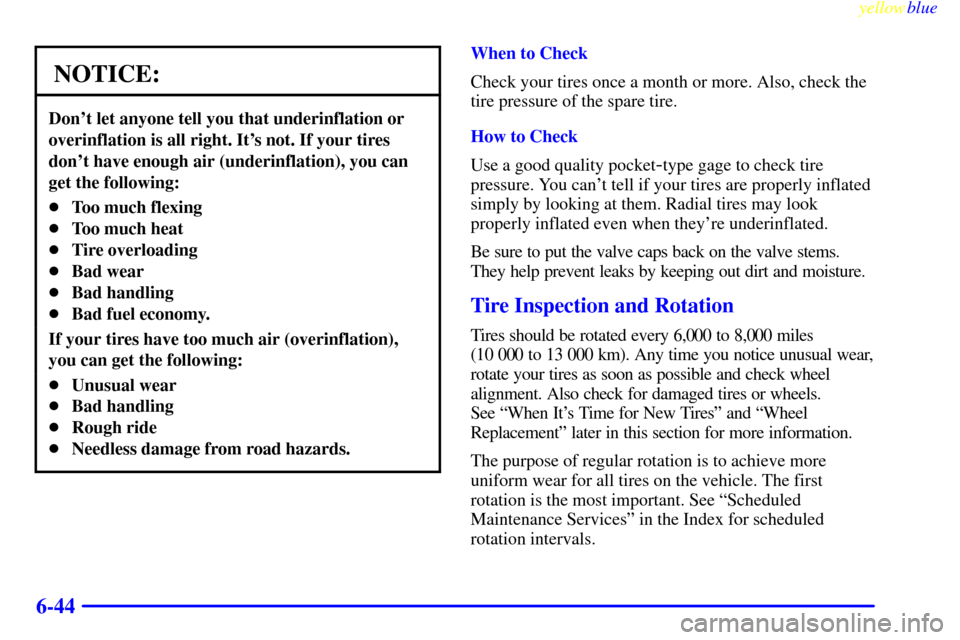Page 284 of 424

yellowblue
6-4
If your vehicle is certified to meet California Emission
Standards (indicated on the underhood emission control
label), it is designed to operate on fuels that meet
California specifications. If such fuels are not available
in states adopting California emissions standards, your
vehicle will operate satisfactorily on fuels meeting
federal specifications, but emission control system
performance may be affected. The malfunction indicator
lamp on your instrument panel may turn on and/or your
vehicle may fail a smog
-check test. If this occurs, return
to your authorized GM dealer for diagnosis to determine
the cause of failure. In the event it is determined that the
cause of the condition is the type of fuels used, repairs
may not be covered by your warranty.
Some gasolines that are not reformulated for low
emissions may contain an octane
-enhancing additive
called methylcyclopentadienyl manganese tricarbonyl
(MMT); ask your service station operator whether or not
his fuel contains MMT. General Motors does not
recommend the use of such gasolines. If fuels containing
MMT are used, spark plug life may be reduced and your
emission control system performance may be affected.
The malfunction indicator lamp on your instrument
panel may turn on. If this occurs, return to your
authorized GM dealer for service.To provide cleaner air, all gasolines in the United States
are now required to contain additives that will help
prevent deposits from forming in your engine and fuel
system, allowing your emission control system to
function properly. Therefore, you should not have to
add anything to the fuel. In addition, gasolines
containing oxygenates, such as ethers and ethanol, and
reformulated gasolines may be available in your area to
contribute to clean air. General Motors recommends that
you use these gasolines, particularly if they comply with
the specifications described earlier.
NOTICE:
Your vehicle was not designed for fuel that
contains methanol. Don't use it. It can corrode
metal parts in your fuel system and also damage
plastic and rubber parts. That damage wouldn't
be covered under your warranty.
Page 287 of 424

yellowblue
6-7
CAUTION:
If you get gasoline on yourself and then
something ignites it, you could be badly burned.
Gasoline can spray out on you if you open the
fuel filler cap too quickly. This spray can happen
if your tank is nearly full, and is more likely in
hot weather. Open the fuel filler cap slowly and
wait for any ªhissº noise to stop. Then unscrew
the cap all the way.
Be careful not to spill gasoline. Clean gasoline from
painted surfaces as soon as possible. See ªCleaning the
Outside of Your Vehicleº in the Index.When you put the cap back on, turn it to the right
(clockwise) until you hear a clicking sound. Make sure
you fully install the cap. The diagnostic system can
determine if the fuel cap has been left off or improperly
installed. This would allow fuel to evaporate into the
atmosphere. See ªMalfunction Indicator Lampº in
the Index.
NOTICE:
If you need a new cap, be sure to get the right
type. Your dealer can get one for you. If you get
the wrong type, it may not fit properly. This may
cause your malfunction indicator lamp to light
and your fuel tank and emissions system may be
damaged. See ªMalfunction Indicator Lampº in
the Index.
Page 324 of 424

yellowblue
6-44
NOTICE:
Don't let anyone tell you that underinflation or
overinflation is all right. It's not. If your tires
don't have enough air (underinflation), you can
get the following:
�Too much flexing
�Too much heat
�Tire overloading
�Bad wear
�Bad handling
�Bad fuel economy.
If your tires have too much air (overinflation),
you can get the following:
�Unusual wear
�Bad handling
�Rough ride
�Needless damage from road hazards.
When to Check
Check your tires once a month or more. Also, check the
tire pressure of the spare tire.
How to Check
Use a good quality pocket
-type gage to check tire
pressure. You can't tell if your tires are properly inflated
simply by looking at them. Radial tires may look
properly inflated even when they're underinflated.
Be sure to put the valve caps back on the valve stems.
They help prevent leaks by keeping out dirt and moisture.
Tire Inspection and Rotation
Tires should be rotated every 6,000 to 8,000 miles
(10 000 to 13 000 km). Any time you notice unusual wear,
rotate your tires as soon as possible and check wheel
alignment. Also check for damaged tires or wheels.
See ªWhen It's Time for New Tiresº and ªWheel
Replacementº later in this section for more information.
The purpose of regular rotation is to achieve more
uniform wear for all tires on the vehicle. The first
rotation is the most important. See ªScheduled
Maintenance Servicesº in the Index for scheduled
rotation intervals.
Page 347 of 424
yellowblue
6-67
Capacities and Specifications
Please refer to ªRecommended Fluids and Lubricantsº in the Index for more information.
Engine Identification -- Gasoline Engines
EngineªVORTECº 5700 ªVORTECº 7400
Type V8 V8
RPO Code L31 L29
VIN Code R J
Fuel System SFI* SFI*
*Sequential Fuel Injection
Wheels and Tires
MODEL DESCRIPTION TORQUE
C 1500 5 bolts (14 mm)
140 lb
-ft (190 N´m)
K 1500, C
-K 25006 bolts (14 mm)
140 lb-ft (190 N´m)
C
-K 25008 bolts (14 mm)
140 lb-ft (190 N´m)
Tire Pressure See the Certification/Tire label
on the rear edge of the driver's
door or the incomplete vehicle
document in the cab.
Page 348 of 424

yellowblue
6-68 Cooling System Capacity (Approximate)
After refill, the level must be rechecked. See ªCooling Systemº in the Index.
ENGINE VIN QTY Without Rear Heater QTY With Rear Heater
ªVORTECº 5700 V8 R 17.5 Quarts (16.5 L) 20 Quarts (19 L)
ªVORTECº 7400 V8 J 25 Quarts (23.5 L) 27.5 Quarts (26 L)
Crankcase Capacity (Approximate)
After refill, the level must be rechecked. Add enough engine oil so that the fluid is within the proper operating range.
See ªEngine Oilº in the Index.
ENGINE VIN
QUANTITY WITH FILTER�
ªVORTECº 5700 V8 R 5 Quarts (4.8 L)
ªVORTECº 7400 V8 J 6.6 Quarts (6.3 L)
�Oil filter should be changed at every oil change.
Fuel Tank Capacity (Approximate)
TYPE QUANTITY
Utility 30 Gallons (113 L)TYPE QUANTITY
Suburban
- Gasoline 44 Gallons (167 L)
Suburban
- Diesel 42 Gallons (159 L)
Air Conditioning Refrigerants
Not all air conditioning refrigerants are the same. If the air conditioning system in your vehicle needs refrigerant, be sure
the proper refrigerant is used. If you're not sure, ask your dealer.
See refrigerant charge label under the hood for charge capacity information and requirements.
Page 349 of 424

yellowblue
6-69
Normal Maintenance Replacement Parts -- Gasoline Engines
Replacement part numbers listed in this section are based on the latest information available at the time of printing,
and are subject to change. If a part listed in this manual is not the same as the part used in your vehicle when it was
built, or if you have any questions, please contact your GM truck dealer.
EngineªVORTECº 5700 V8 ªVORTECº 7400 V8
VIN R J
Oil Filter
AC Type PF1218�AC Type PF1218
Air Cleaner Filter
AC Type A1300C��AC Type A1300C��
PCV Valve AC Type CV769C AC Type CV774C
Spark Plugs
AC Type 41
-932 AC Type 41-932
Spark Plug Gap 0.060 in. (1.52 mm) 0.060 in. (1.52 mm)
Fuel Filter AC Type GF626 AC Type GF626
Wiper Blades (Front) GM Part No. 22154886 GM Part No. 22154886
Wiper Blade Type (Front) Trico Trico
Wiper Blade Length (Front) 18 inches (45.0 cm) 18 inches (45.0 cm)
Wiper Blade (Rear) GM Part No. 22154396 GM Part No. 22154396
Wiper Blade Type (Rear) Trico Trico
Wiper Blade Length (Rear) 14 inches (35.5 cm) 14 inches (35.5 cm)
�Four
-Wheel-Drive Vehicles -- use a PF52 oil filter.
��A1301C High
-capacity air cleaner filter.